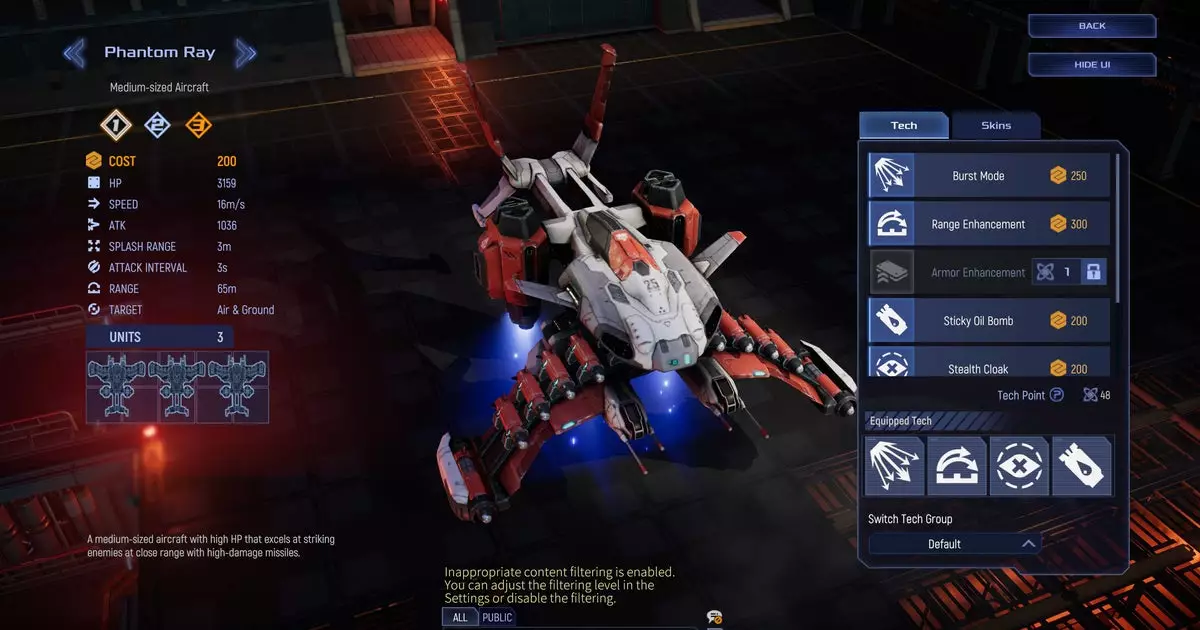Mechabellum, a strategic autobattler that captured players’ attention with its initial launch, has continued to endure as an engaging title within the gaming community. Since its arrival in September, I have been immersed in its intricate mechanics and strategic depth. However, with the release of update 1.1, my experience has significantly shifted, comparable to a sudden gale that disrupts an otherwise calm sea. Game River has introduced the Phantom Ray, an innovative unit that evokes both intrigue and challenge. The stealth capabilities of this medium-sized aircraft take the assurance of players into uncharted territory, making it essential to reassess existing strategies while incorporating this new variable.
The Phantom Ray promises a fresh approach to battles, offering a blend of durability and offensive prowess. Priced at 50 for unlocking and 200 for deployment, the inclusion of three units per configuration increases its appeal for strategic gamers. Armed with high HP and powerful missiles, this unit excels at close-range engagements, and its stealth feature cloaks it until it strikes. The added 40% damage bonus upon attacking presents a robust opportunity for ambush tactics. This further enables players to rethink their formations and unit placements. My immediate response to this drastic change was to re-evaluate my approach and optimize my overall strategy to accommodate this stealth mechanic.
The introduction of the Phantom Ray isn’t just a standalone addition; it is accompanied by various balancing changes to several existing units. The Sandworm, Arclight, and Mustang have all undergone adjustments that influence their effectiveness on the battlefield. The Mustang, already a favorite of mine, has received enhancements that bolster its missile interception capabilities, which is vital against the incoming threats of long-range units. Meanwhile, the Stormcallers have been empowered to inflict more damage but at a cost of a prolonged attack interval. This shift necessitates careful timing and positioning, as a balance between offensive output and defensive maneuvers is paramount in competitive play.
Moreover, the notable bug fixes highlight Game River’s commitment to refining player experience. The resolution of issues related to sticky oil mechanics offers reassurance that the developers are attentive to the balances and missteps inherent in real-time strategic gameplay. By ironing out these bugs, the game’s integrity and competitiveness are preserved, allowing players to engage without the frustration of mechanics failing them during critical moments.
Mechabellum may not have initially appeared on my agenda for comprehensive reviews, but the impressive nature of its gameplay and tactical depth has compelled me to devote more time to exploring its nuances. The sheer engagement that this game elicits as a hybrid of resource management and tactical warfare reflects a design philosophy that appeals to strategic thinkers who may find conventional RTS titles daunting. With the opportunity to master game mechanics and formulate strategic responses to adversaries, players can cultivate their skills without the significant time investment typical of traditional titles.
With its engaging engagement loop and vibrant community, Mechabellum has rightfully earned a commendable spot among my favorite games of the year. I would encourage anyone curious about diving into the complex world of real-time strategy games, especially those who feel overwhelmed by the more demanding aspects of traditional formats, to investigate Mechabellum. The streamlined mechanics and approachable gameplay allow for swift learning and competence, making it an inviting realm for strategists and casual players alike.
While the Phantom Ray introduces an exhilarating layer of strategy to Mechabellum, the accompanying balancing changes and bug fixes reflect Game River’s dedication to enhancing gameplay. With the game consistently evolving, players are bound to find a tapestry of tactical opportunities that challenge and reward strategic thinking.

